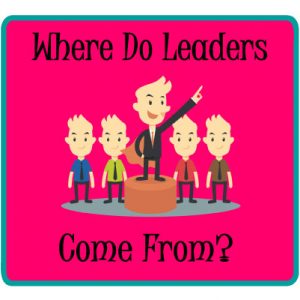 WHAT IS A LEADER?
WHAT IS A LEADER?
In general terms, a leader is a person who has personally enrolled “so many” others and who is active in the business by meeting or exceeding the minimum personal and group volume requirements of the company’s compensation plan.
It would be great if everyone who joined a direct selling company became a leader. Unfortunately, this doesn’t happen. Instead, leaders comprise a small but important minority, usually 5-15% of a sales force.
ARE LEADERS BORN OR GROWN?
There are two schools of thought regarding leadership. One says leaders are born, that is, they have innate qualities predetermined at birth. Leadership is preordained, like eye color.
The other school of thought believes that leadership is a skill. Like spelling, leadership can be learned.
Everyone wants more leaders, but how do you get them? Do you find them or grow them? The answers are “yes” and “yes.”
Only some of the people who join your direct selling company will have leadership experience. This experience was gained while representing another network marketing or party plan company or through other experiences that taught them leadership skills.
Most of your leaders will be new leaders. This means it is up to your company and its leaders to nurture new leaders.
LEADERSHIP DEVELOPMENT
Most leaders in a sales force aren’t naturally born that way.
Leadership development is the name given to a system that identifies prospective leaders and provides them with training, tools, support, and recognition. Your Leadership Development Program should attract and build strong leaders.
An investment in the future of others, leadership development is a priority of all successful direct selling companies. Leaders are vital to the growth of all direct selling companies. In fact, the strongest predictor for the future direction of a direct selling company (up or down) is the number of new first-level leaders.
WHAT IS A LEADERSHIP DEVELOPMENT PROGRAM?
A Leadership Development Program is a company initiative with eight steps. The steps are:
- “Leader” definition.
- “Potential Leader” definition.
- Leadership development
- Leadership training.
- Leadership activities.
- Leadership rewards.
- Leadership promotion.
- Teambuilding culture.
Each step answers an essential question. Here are the eight questions:
- What is a leader?
- What is a potential leader?
- How will potential leaders become leaders?
- What do leaders need to know?
- What do all leaders do?
- What do new leaders receive when they become leaders and what do the upline leaders get when he or she helps in leadership development?
- How do the company and the field promote the leadership opportunity?
- In addition to promoting leadership, how will the company and the field promote teambuilding?
LEADERS ARE IMPORTANT
Leaders are so important to the success of all direct selling companies. They sell more, recruit more, and stay active in the business longer than the average representative. That’s the good news.
The bad news is that, eventually, all leaders stop acting like leaders. Why? There are many reasons and there is a lot you can do to keep them engaged and productive.
We recommend a two-pronged strategy: leader retention and leader recovery.
LEADER RETENTION
Leaders stop leading when one or more of the following are present:
- personal priorities have changed
- disenchantment occurs in response to changes in your company that are unfavorable to leaders
- unhappiness is present with an upline leader
- there is poor or absent leadership from the company
- company training of leaders is poor
- leaders don’t have personal goals
- the company or leadership politics make leaders feel uncomfortable
- the company provides inadequate recognition
- your compensation plan does not provide leaders with sufficient rewards for their contributions
Retention is doing all you can to keep your representatives engaged and active in the business as long as possible. Leader retention is providing leaders with the opportunities, recognition, and rewards that leaders want.
To keep leaders engaged, direct selling companies must:
- have a leadership development program
- train and retrain leaders
- consider how changes will affect leaders
- provide leaders with advance notice of upcoming changes
- communicate to leaders the benefits that leaders will experience
- teach leaders how to set personal goals
- recognize privately and publicly leadership achievements
- be consistent in how they respond to leader complaints about other leaders
LEADER RECOVERY
If you are measuring both company and individual consultant performance metrics in a set of key operating indicators, you can tell when individual leaders, and when leaders as a group, stop leading.
Here are steps your company can take to get leaders leading again:
- remind leaders of the benefits of leadership
- revisit past achievements and ask how they felt when they accomplished these goals
- help them to set new goals
- on a personal level, find out why each leader stopped leading and then respond, when possible, with specific solutions
- offer to work with leaders personally to help them to get growing again
Don’t make the mistake of threatening leaders with discipline as a consequence of inactivity. Like all independent representatives, even your leaders are volunteers.
ATTRACTING LEADERS
If you have an established party plan or network marketing company with annual sales of $50 million or more, you are likely to attract top leaders because you have a proven track record.
But what if you’re new or your annual sales are less than $50 million? To attract top leaders, your track record isn’t enough, so to attract them, you may need to take other steps. Here are some things you can do to attract them:
- Have a strong leadership development program. This will show them that you understand the best predictor of success of a direct selling company.
- Show them that your company is stable and well-funded. They need to know that their time, energy, and commitment to your company will be reciprocated with longevity.
- Make sure you have a good compensation plan. If you’re not sure, call us at Sylvina Consulting at 503.244.8787. We offer a free professional opinion.
- Don’t hide the identities of your owners and executives from your website or your marketing materials. Top leaders need to know who is running your company and what each person brings to your success team.
- Implement a Founder Program with additional rewards for achievers. Don’t make the mistake of paying top leaders for past achievements. Use a “pay for performance” approach instead.
- Offer products that people purchase more than once, preferably through an auto-ship program. While not every company’s products are suitable for delivery through an auto-ship program, if your products can be sold this way, you should.
You can do even more! Proactively participate in LinkedIn groups, contributing to the conversations in meaningful ways. In short posts, share information about your leadership development program, your company’s stability, the backgrounds of owners and executives, the existence of a Founder Program, etc. In other words, use the six steps above because these things matter to top leaders who may be looking to join a new company like yours.
COMPENSATION PLAN BEHAVIORS
Did you know that compensation plans should encourage and reward 12 specific behaviors, three of which are leadership development behaviors?
THE 12 BEHAVIORS
- Personally purchasing your products or services
- Selling to customers (non-participants of the income opportunity)
- Introducing the income opportunity to others (sponsoring)
- Building a team
- Training, supporting, and nurturing others
- Becoming a leader
- Personally developing leaders
- Helping other leaders to develop leaders
- Meeting or exceeding minimum activity requirements
- Being promoted to a higher rank or title
- Meeting or exceeding rank maintenance requirements
- Staying active and engaged in the business (retention)
SYMPTOMS OF PLANS IN NEED OF IMPROVEMENT
Compensation plans that should be improved exhibit one or more of the following symptoms:
INSUFFICIENT RECRUITING
If the percentage who have recruited is less than your goal percentage, your compensation plan needs attention, or your goal needs to be revised downward, or perhaps both.
LOW SECONDARY RANK ADVANCEMENTS
If your compensation plan’s secondary rank advancement percentage is less than your goal, either your compensation plan needs to be adjusted to meet that goal, your goal needs to be lowered, or both.
UNBALANCED HIGHER RANK ADVANCEMENTS
The percentage who advance to each rank in your compensation plan will vary. High percentages are indicative of easy rank promotions, whereas low percentages are symptoms of difficult rank advancements. Compare the results with your goals to identify areas in need of adjustment. Also, pay attention to wild swings in the percentages. They shouldn’t be present.
INSUFFICIENT LEADERSHIP
Every compensation plan should have leadership ranks. The first of these leadership ranks deserves special attention. If your leadership percentage is less than your goal, your compensation plan may need to be adjusted or perhaps an earlier rank should be treated as the first leadership rank.
LACKING RETAIL SALES
Some direct selling companies encourage sales to non-participants in the income opportunity. If your percentage of sales to non-participants is less than your target or if it is trending downward, your compensation plan may need attention.
INADEQUATE ACTIVITY
Your compensation plan likely has a monthly personal sales volume activity requirement or perhaps a requirement that sums personal sales over several consecutive months. If your percentage active is less than your target or if it is trending downward, your compensation plan and/or other areas of your business may need attention.
CONCLUSION
For more information on these topics and other topics of interest to direct selling company owners and employees, visit https://www.sylvina.com.


 Jay Leisner, the President of Sylvina Consulting, is a top compensation plan and direct selling expert, a trusted adviser to new and established network marketing and party plan companies. For more than 30 years, Jay has enjoyed assessing and improving network marketing, party plan and referral marketing companies across the globe.
Jay Leisner, the President of Sylvina Consulting, is a top compensation plan and direct selling expert, a trusted adviser to new and established network marketing and party plan companies. For more than 30 years, Jay has enjoyed assessing and improving network marketing, party plan and referral marketing companies across the globe.
Leave a Reply